
Main Menu - Misc. - Clothing/Textiles - Medieval Wales - Names - Other Medieval - Publications - Harpy Publications
Return to main page
One of the fascinating incidental topics that came up in the course of this study (in fact, a key inspiration of it) is the motif of an assortment of tools and other objects hung from the Shepherds Purse, or from a belt in association with it (or more rarely, alone on a shepherd who wears no pouch of any type). While it's common for people of all sorts to wear knives on their belts (and, of course, pouches of various types), in the artwork that I studied, the other types of attached tools are strongly, if not uniquely, associated with shepherds, and represent certain specific repeating types (even if the purpose of the type of object is not always clear). In general, attached objects tend to occur throughout a group of shepherds if they appear at all, and the method of attachment tends to be consistent throughout a group.
The method of attachment for these objects varies somewhat. In a significant number, the method of attachment is unclear -- perhaps the artwork is insufficiently detailed to show it clearly. The tools may be attached to a separate belt -- either by rings, lying above the pouch, or presumably by some method to a belt underneath the pouch (where the objects are partially visible under the lower edge of the pouch). If the objects are attached to the pouch itself, it may be by some unknown method to the lower edge of the pouch, or most commonly by rings sewn onto the upper edge of the pouch (or near the upper edge).
As noted in the overview, the appearance of attached objects occurs more narrowly than that of the Shepherds Purse style in general, being confined to the late 15th century and later (in effect, late 15th century and throughout the 16th century). Given that they are primarily associated with Shepherds Purses, this also means that they are primarily associated with France and the Low Countries.
This is a typical example; click here for the full catalog. This style is strongly associated with tapestries of the first half of the 16th century.

This style may be more common than the examples here indicate. In cases where the attachment method is hidden behind the pouch, it is probably to a separate belt.


scenes of childhood/annunciation



In several sources, objects are visible at the bottom of a pouch and appear to be attached either to the bottom edge of the pouch or to a belt lying hidden under the pouch. The majority of these fall in the same period as the ring-attachments, but occur in manuscripts rather than tapestries. Click here for full catalog.
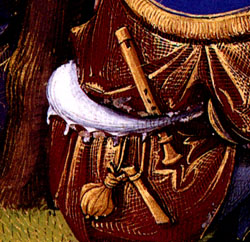
When attached objects occur, there are some common repeating patterns, while others occur rarely, and many are difficult or impossible to identify as to their specific nature. For the more common objects, the full catalog is on a separate page, and only a type example is shown here.
Knives are the most common type of attached object, not entirely surprisingly. Among other social groups, knives may be worn in a variety of manners, but when multiple objects appear for a shepherd, the knife is typically hung in the same manner as the other objects. These tend to be relatively small knives -- the typical medieval utility knife, not anything fancy. Click here for full catalog.

There is a single example of what looks like a small pruning hook -- a crescent-shaped blade on a short handle. If I have misidentified this, then I'm not certain what it might be.
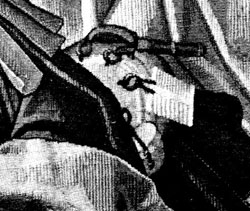
A variety of shapes and types of scissors appear, although there are relatively few examples in total. Hinged scissors with ring-looops are the most common type, both in a relatively large size and, in a relatively indistinct example, something looking like embroidery snips. There is also an example of one-piece spring shears in a medium size. (There are also examples of shepherds using this style of shears to shear sheep in the pictures, but here I include only examples attached to the person.) Click here for a full catalog.

When combs appear, they are always of the double-sided variety. The attachment method isn't always clear, but in some cases there appears to be a cord loop that is slipped in turn between the end teeth on each side to hold it by the spine. Click here for full catalog.

The nature of the artifact here is largely a guess. It is a round, light-colored frame enclosing a dark center with highlights suggesting that it is both convex and extremely reflective. A larger object with similar properties is seen in the series of "Senses" tapestries (not included here) under "Sight", where it seems clearly intended to be a mirror. A small hand-mirror seems somewhat unlikely for an actual shepherdess, but in these two tapestries (which appear to be part of a set) the "shepherds" are awfully well-dressed in general, and as an accessory for "noble people playing at being shepherds", a mirror might not be quite so out of place. Click here for full catalog.

scene of hunting and shepherding #1
The musical instrument most closely associated with shepherds in art is the bagpipes. (The notion that bagpipes are somehow inherently a "Celtic" instrument is a modern invention. In medieval art, bagpipes = shepherds and shepherds = bagpipes.) But other instruments can be found either attached to, or thrust under, a belt or pouch. Although this is an extensive group, there are a variety of specific instruments involved. I have chosen a flute as representative -- click here for the full catalog.
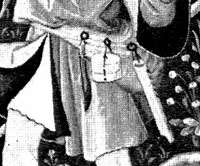
After knives, the most widespread type of object hung from the pouch or belt is a small round or oval box. When details can be discerned, the design is remarkably consistent. The box lid fits down over the box, and the cord or strap from which the box hangs goes through loops or slots on the sides of the lid, and then attaches to the box, so that the lid can be slid up and off while both parts are still attached securely. Another style shows a cord attached to a loop or ring on the top of the box, but doesn't indicate any attachment mechanism between box and lid. Click here for the full catalog.

Rigid containers for liquid are relatively uncommon as pouch or belt attachments, although they may sometimes be found as separate objects, as in the Stockholm-Kessel Hours, or present in the scene, but not worn on the person, as in Repas Champetre or the Pigouchet annunciation. The scene below shows the true "costrel" shape -- a sideways barrel, with an opening on the top of one side. Click here for the full catalog.

It isn't uncommon to see shepherds (or shepherdesses in particular) wearing drawstring purses from a belt when not wearing a Shepherds Purse, however this survey is limited to examples where a drawstring purse is attached to a Shepherds Purse, or is attached to a belt in combination with other tools. Click here for full catalog.

A string of Paternoster beads occurs only once as an attachment to a pouch. The string contains 23 beads and a small cross.
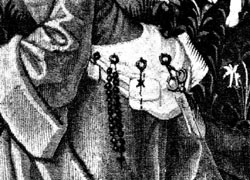
A number of objects are not identifiable to me as to function, but certain shapes are repeated. Only one of each is shown -- click here for a full catalog. Similar shapes may represent objects of similar function, but this isn't certain. The identifiable shape-groups include squares, spindle-shapes, and narrow cylinders.


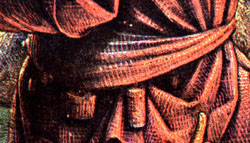
Grande Heures of Anne of Brittany
Previous --------------------------------------------- Main --------------------------------------------- Next
This site belongs to Heather Rose Jones. Contact me regarding anything beyond personal, individual use of this material.
Unless otherwise noted, all contents are copyright by Heather Rose Jones, all rights reserved.